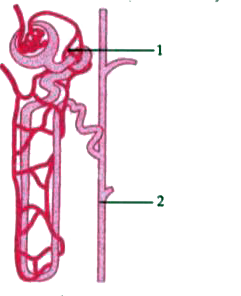The structures in a human that provide balance are located in the :
pinna
middle ear
inner ear
eustachian tubes
The correct Answer is:B
To answer the question about where the structures in a human that provide balance are located, we can follow these steps:
1. Identify the Options: The question provides four options: pinna, middle ear, inner ear, and Eustachian tube.
2. Understand the Function of Each Part:
- Pinna: This is the outer part of the ear that collects sound waves but does not play a role in balance.
- Middle Ear: This part contains the eardrum and ossicles (small bones) that transmit sound but is not involved in maintaining balance.
- Inner Ear: This part contains structures that are crucial for balance and hearing. It includes the cochlea (for hearing) and the vestibular system (for balance).
- Eustachian Tube: This tube connects the middle ear to the throat and helps equalize pressure but does not contribute to balance.
3. Focus on the Inner Ear: The inner ear houses the vestibular system, which is responsible for maintaining balance. It consists of:
- Semicircular Canals: Three fluid-filled canals arranged at right angles to each other, detecting rotational movements.
- Otolith Organs: These include the utricle and saccule, which detect linear acceleration and the effects of gravity.
4. Conclude the Answer: Based on the functions of these structures, the correct answer to the question is that the structures that provide balance are located in the inner ear.
Final Answer:
The structures in a human that provide balance are located in the inner ear.
---
- Pinna: This is the outer part of the ear that collects sound waves but does not play a role in balance.
- Middle Ear: This part contains the eardrum and ossicles (small bones) that transmit sound but is not involved in maintaining balance.
- Inner Ear: This part contains structures that are crucial for balance and hearing. It includes the cochlea (for hearing) and the vestibular system (for balance).
- Eustachian Tube: This tube connects the middle ear to the throat and helps equalize pressure but does not contribute to balance.
- Semicircular Canals: Three fluid-filled canals arranged at right angles to each other, detecting rotational movements.
- Otolith Organs: These include the utricle and saccule, which detect linear acceleration and the effects of gravity.
The structures in a human that provide balance are located in the inner ear.
Topper's Solved these Questions
- BOOK - ICSECHAPTER - NEURAL CONTROL AND CO-ORDINATION EXERCISE - TEST YOUR PROGRESS ( OBJECTIVE TYPE QUESTIONS ) (Fill in the blanks with appropriate words.)14videos
NEURAL CONTROL AND CO-ORDINATION
- BOOK - ICSECHAPTER - NEURAL CONTROL AND CO-ORDINATION EXERCISE - TEST YOUR PROGRESS ( OBJECTIVE TYPE QUESTIONS ) (State whether the following statements are true or false .)9videos
NEURAL CONTROL AND CO-ORDINATION
- BOOK - ICSECHAPTER - MORPHOLOGY OF FLOWERING PLANTS EXERCISE - NCERT TEXTBOOK QUESTIONS WITH SOLUTIONS25videos
MORPHOLOGY OF FLOWERING PLANTS
- BOOK - ICSECHAPTER - NEURAL CONTROL AND COORDINATIONEXERCISE - (Review question) long answer20videos
NEURAL CONTROL AND COORDINATION
Similar Questions
Knowledge Check
- Question 1 - Select One
The structures in a human body that assist in body balance are located in the
Aouter earBmiddle earCinner earDEustachian tube
In the structure of a human neuron, the nodes of Ranvier are present on
View SolutionIn humans, kidneys are located between the levels of
View SolutionHow many endocrine glands are located in human brain
View SolutionThe structure which provides vascular connection between the fetus and uterus is called __________.
View SolutionThe diagram given below is that of a structure present in a human kidney. Study the same and answer the questions that follow:

Name the structure represented in the diagram.View SolutionSupportive skeletal structures in the human external ears and nose tip are of
View SolutionSupportive skeletal structures in the human external ears and nose tip are of
View Solution

